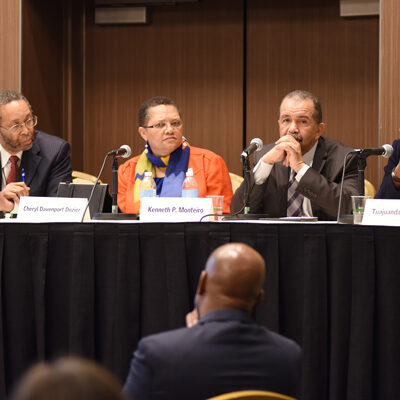By Joana Dos Santos
The National Center for Institutional Diversity at the University of Michigan interviewed a number of academic diversity officers (ADOs) to learn more about how they view their role. Results from this study were published last fall. In this new blog series, ADOs and other senior leaders discuss the role, the challenges ADOs face, and the opportunities these positions bring to college and university campuses.
This post was originally published in Diverse: Issues In Higher Education. The designation Unit-based Chief Diversity Officers (UBCDO) is equal to ADO used in other posts in this series.
In 2011, I was arrested for civil disobedience in front of the U.S. Senate, fighting for immigrant rights. While I was being arrested, children of undocumented parents visited senators with heart-shaped cookies asking them to take action on keeping families together. Sound familiar? We were using two key principles of community organizing to create culture and systemic change: pushing for policy change and changing people’s hearts.
Forward to 2017: I find myself working on diversity, equity and inclusion (DEI) in higher education. My background is in community organizing and organizational leadership. I’m in a field that is new to me and is still developing. There are no guidelines. But I know how to create culture and systemic change through policy and healing. This is how I embarked on my new journey as a unit-based chief diversity officer.
Unit-based Chief Diversity Officers (UBCDO) are the newest addition to the growing field of Diversity, Equity and Inclusion in higher education. Katrina Wade-Goldman and Damon Williams define the role of the CDO in higher education (the latest iteration of a long history of staff and administrators working towards advancing DEI, before it was called DEI) as an administrator, reporting to the president or provost who is responsible for the institution’s “inclusion and excellence for all.” The role of the UBCDO is the same as the CDO, except that it is within academic and non-academic units.
Or is it something else?
According to a study on the Experiences of Academic Diversity Officers (ADO) by the National Center for Institutional Diversity, UBCDOs play different roles depending on the unit they are in. They can be in charge of strategic planning and make decisions about DEI efforts that affect the entire unit or be implementers only. Some of them are dedicated full-time DEI staff, others are part-time staff, faculty, or administrators. In large units, they can be a team of multiple full-time people.
As middle managers, autonomy and leadership is unclear.
Units are not clear on how to implement DEI efforts and what they should be asking from CDOs. Some give more autonomy and leadership than others. From day one, I took leadership of our unit’s DEI strategic plan. Students, faculty and staff needed to know what our DEI strategy is in order to implement it. So given that I am a community organizer, I organized community meetings and visual campaigns to teach and engage people. I incorporated changes from feedback received in the process of implementation to make the DEI plan a “living” document. This was possible because I was given freedom and autonomy to do my work.
Different backgrounds, experiences (and responsibilities).
In my tenure as director of a Latinx community center, I used DEI values and strategies to build coalitions among government officials, non-profits, police, schools and colleges, and community members to advance racial justice. If organizing worked to change policies and culture at the community level, I thought, it should certainly work in higher education. And it worked! Students, faculty and staff are sitting at meetings together talking about how they can collaborate. Student clubs are planning on incorporating DEI practices into their programming. Next year’s strategic plan incorporated the voices of all of my unit’s constituencies. Our community is excited to integrate all of our identities and shared values; breathing new air into their respective fields and leading a new era of inclusive design and planning.
The ADO study found that UBCDOs bring many different experiences and skills to the table. In the study, UBCDOs were community organizers, student affairs professionals, higher ed administrators (from different positions/backgrounds) and faculty. Some of them were in higher education for a long time, bringing institutional knowledge, while others are newer to the field. The majority were women of color. Some were trainers and implementers; others developed policies. What they had in common was DEI competency. For this reason, it is important to be clear about what characteristics, skills and experiences are most beneficial when hiring for UBCDO positions.
UBCDOs recommendations
Recognition that UBCDOs exist: The first time I went to a higher education conference, I went to a conference for CDOs. To my disappointment, the entire conference was dedicated to university level CDOs, excluding college or unit-level officers. As future university level CDOs, we need to be included in the field. We need to be part of conferences, discourse, and decision-making.
Develop Standards of Practice: The National Association of Diversity Officers in Higher Education put out the NADOHE CDO Standards of Practice. Creating standards of practice of UBCDOs is a great first step to clarify the roles of these practitioners and the leadership structure at the unit level and within the DEI field. DEI as a field and institutions must adopt these standards of practice as a way to be accountable to themselves and UBCDOs.
Hire leaders and create leadership positions: For DEI to be successful, culture and climate change must be the ultimate goal. But if the people tasked with achieving this goal have no decision-making power or do not know how to lead, this could become an impossible goal. Unit leadership and supervisors must give UBCDOs support, leadership and autonomy, or risk failing. Hire people who have been organizational leaders or show leadership potential. Someone who will only follow directions (or is only allowed to follow directions) will not create institutional change.
And don’t forget the job title: UBCDOs need to have the authority to change culture and policy. Many of the ADO study participants were program managers, specialists, or coordinators. Those who were most successful in creating change were those who held titles of “director”, “assistant dean” and “chief officers”. Responsibilities for organizational change must match titles and compensation.
A way forward
A cross-unit partnership led me to meet with university leadership about the work I was doing. The first thing that a university administrator told me when she saw me was “why are you here?” This sent me the message that there was no expectation of leadership from me at this level. By creating standards of practice for unit-based CDOs, elevating our role in the field, and becoming recognized decision makers and institutional leaders, we will be able to forge a better path forward towards advancing DEI in higher education. Next time I’m in this type of situation, I want my leadership to be expected and demanded.
If you have any questions or comments about this blog post, please contact us.


